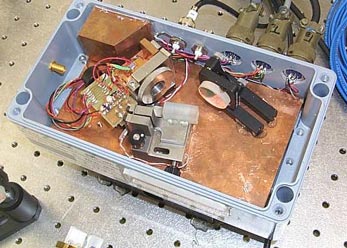
|
|
|
|
Diode Laser Technology
|
|
|
|
|

In the NIST Optical Frequency Measurements Group, diode lasers are used extensively, and almost exclusively, for spectroscopy, atomic physics, and non-linear optics. The advantages of using diode lasers in these applications are low cost, reliability, tunablilty, low amplitude noise, and the ability to modulate at high frequencies. Unfortunately, conventional, unmodified lasers typically have a spectral linewidth too large (a few tens of MHz) to be easily used in most spectroscopic applications; often the power is also too low (a few mW). Longitudinal mode hops can also prevent the laser from tuning to a specific atomic line. A number of technologies have therefore been adopted to overcome these difficulties and make the lasers more useful for laboratory experiments.
Extended cavity diode lasers (ECDLs) are perhaps the most commonly used laser in the OFM Group. These lasers have a substantially reduced linewidth (down to a few 100 kHz) with only a moderate sacrifice in output power (about a factor of two). They can be continuously tuned over several hundred GHz, making them ideal for spectroscopy. An image of a typical ECDL constructed in the OFM Group is shown above.
In order to reach higher power levels required for some experiments, Master Oscillator Power Amplifiers (MOPAs) are used. These uinits are single pass tapered amplifier chips, usually injected with a ECDL. Up to 500 mW can be obtained while retaining the tunability and narrow linewidth of the injecting laser. MOPAs are available at a number of wavelengths including 850nm, 795nm, 780nm and 660nm.
Two technologies which also find use in the Optical Frequency Measurements Group are Distributed Feedback (DFB) lasers and Distributed Bragg Reflector (DBR) lasers. These devices incorporate micron-sized gratings into the laser structure, making them oscillate in a single longitudinal mode. They are easily tunable and can almost always reach any given wavelength within their tuning range. For some devices, high powers (up to 150 mW) can be obtained while other types offer narrow linewidth (< 1 MHz).
John Kitching, NIST, [email protected]
References: